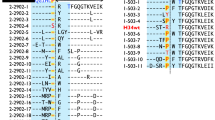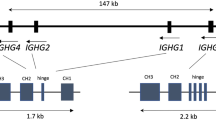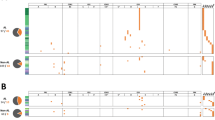Abstract
A VARIANT of myeloma has been described1,2; it is known as heavy chain disease, and is characterized by the presence of a homogeneous serum and urinary protein bearing only the antigenic determinants associated with the heavy or γ-chain of human IgG immunoglobulin. Five such cases have been described, but the protein of two patients, Zu1 and Cr2,3, have been more extensively investigated because of the availability of material and appear to share common structural features. The proteins are symmetrical dimers, stabilized by disulphide bonds, with molecular weights in the range of 50,000–55,000. Peptide maps reveal they contain the Fc portion of the heavy chain as a chief structural unit3. This conclusion is supported by the content of carbohydrate3, the presence of Gm specificities4, and biological activities5,6 of these proteins, properties also attributed to the C-terminal half of the heavy chain.
This is a preview of subscription content, access via your institution
Access options
Subscribe to this journal
Receive 51 print issues and online access
$199.00 per year
only $3.90 per issue
Buy this article
- Purchase on Springer Link
- Instant access to full article PDF
Prices may be subject to local taxes which are calculated during checkout
Similar content being viewed by others
References
Osserman, E. F., and Takatsuki, K., Amer. J. Med., 37, 351 (1964).
Franklin, E. C., Lowenstein, J., Bigelow, B., and Meltzer, M., Amer. J. Med., 37, 332 (1964).
Franklin, E. C., J. Exp. Med., 120, 691 (1964).
Terry, W. D., Fahey, J. L., and Steinberg, A. G., J. Exp. Med., 122, 1087 (1965).
Terry, W. D., J. Immunol., 95, 1041 (1966).
Spiegelberg, H. L., and Weigle, W. O., J. Immunol., 95, 1034 (1966).
Press, E. M., Piggot, P. J., and Porter, R. R., Biochem. J., 99, 356 (1966).
Piggot, P. J., and Press, E. M., Biochem. J., 99, 16P (1966).
Prahl, J. W., Proc. Roy. Soc., B, 166, 220 (1966).
Prahl, J. W., Biochem. J. (in the press).
Turner, M. W., and Rowe, D. S., Nature, 210, 130 (1966).
Berggard, I., and Bennich, H., Nature, 214, 697 (1967).
Phillips, D. M. P., Biochem. J., 68, 35 (1958).
Bettelheim, F. R., J. Biol. Chem., 212, 235 (1955).
Stark, G. R., and Smyth, D. G., J. Biol. Chem., 238, 214 (1963).
Piggot, P. J., and Press, E. M., Biochem. J., 104, 616 (1967.)
Wilkinson, J. M., Press, E. M., and Porter, R. R., Biochem. J., 100, 303 (1966).
Ikenaka, T., Bammerlin, H., Kaufmann, H., and Schmid, K., J. Biol. Chem., 241, 5560 (1966).
Press, E. M., and Piggot, P. J., Cold Spring Harbor Symp. Quant. Biol., 32 (in the press, 1967).
Askonas, B. A., and Williamson, A. R., Proc. Roy. Soc., B,166, 232 (1966).
Author information
Authors and Affiliations
Rights and permissions
About this article
Cite this article
PRAHL, J. N-and C-terminal Sequences of a Heavy Chain Disease Protein and its Genetic Implications. Nature 215, 1386–1387 (1967). https://doi.org/10.1038/2151386a0
Received:
Issue Date:
DOI: https://doi.org/10.1038/2151386a0
This article is cited by
-
Heavy chain diseases in man
La Ricerca in Clinica e in Laboratorio (1976)
-
Detection in Normal Plasma of Immunoglobulin resembling the Protein of γ-Chain Disease
Nature (1973)
-
Le malattie delle catene pesanti
La Ricerca in Clinica e in Laboratorio (1971)
-
Partial Deletion in the Heavy Chain Disease Protein ZUC
Nature (1969)
Comments
By submitting a comment you agree to abide by our Terms and Community Guidelines. If you find something abusive or that does not comply with our terms or guidelines please flag it as inappropriate.



